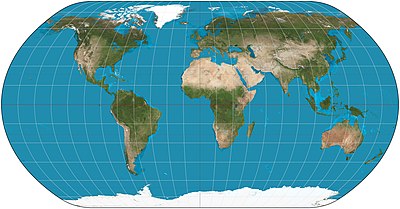This article is missing information about distortion, software support and the polynomial. (February 2017) |


The Natural Earth projection is a pseudocylindrical map projection designed by Tom Patterson and introduced in 2008.[1] It is neither conformal nor equal-area, but a compromise between the two.
In its original presentation, the projection's origin is described as "The impetus for creating the Natural Earth projection was dissatisfaction with existing world map projections for displaying physical data." Further criteria follow, ending with "The ideal projection needed to be both functional and rather familiar in appearance."[1]
The Natural Earth projection was originally designed in Flex Projector, a specialized software application that offers a graphical approach for the creation of new projections.[1] Subsequently, Bojan Šavrič developed a polynomial expression of the projection.[2][3]
The projection may also be referred to as the Natural Earth I projection, due to subsequent development of a Natural Earth II projection.[4][5] The same group later developed the Equal Earth projection.
- ^ a b c Jenny, Bernhard; Patterson, Tom; Hurni, Lorenz (2008). "Flex Projector–Interactive Software for Designing World Map Projections". Cartographic Perspectives (59): 12–27. doi:10.14714/CP59.245. Retrieved May 21, 2023.
- ^ Šavrič, Bojan (2011). Derivation of a Polynomial Equation for the Natural Earth Projection (Thesis). University of Ljubljana, Slovenia.
- ^ Šavrič, Bojan; Jenny, Bernhard; Patterson, Tom; Petrovič, Dušan; Hurni, Lorenz (February 17, 2012). "A Polynomial Equation for the Natural Earth Projection" (PDF). Oregon State University. Archived from the original (PDF) on 2016-03-03. Retrieved January 24, 2020.
- ^ Šavrič, Bojan; Patterson, Tom; Jenny, Bernhard (2015). "The Natural Earth II world map projection". Intl. J. Cartogr. 1 (2): 123–133. doi:10.1080/23729333.2015.1093312. S2CID 130666492. Retrieved 2023-05-21.
- ^ "Natural Earth II—ArcGIS Pro | Documentation". pro.arcgis.com. Retrieved 2023-12-21.